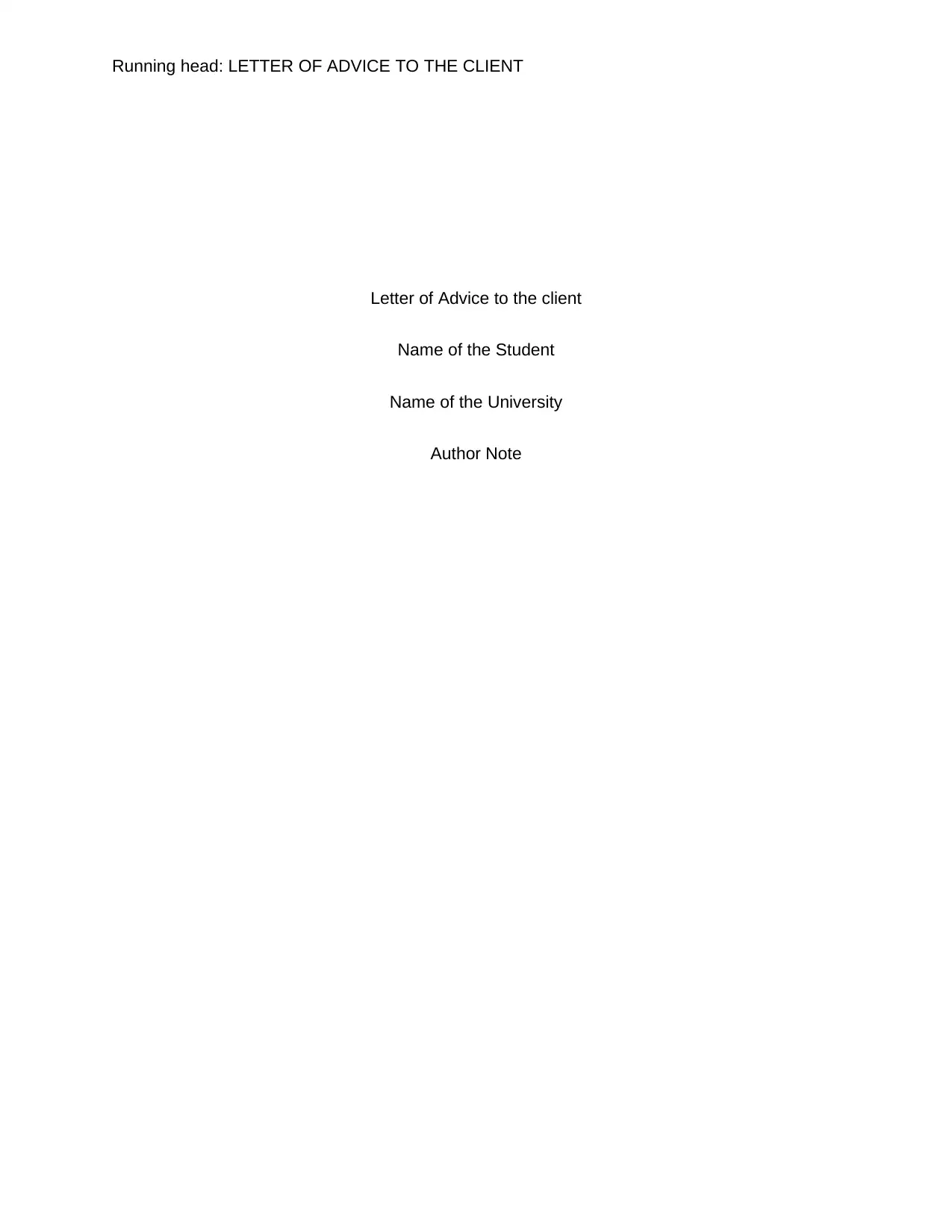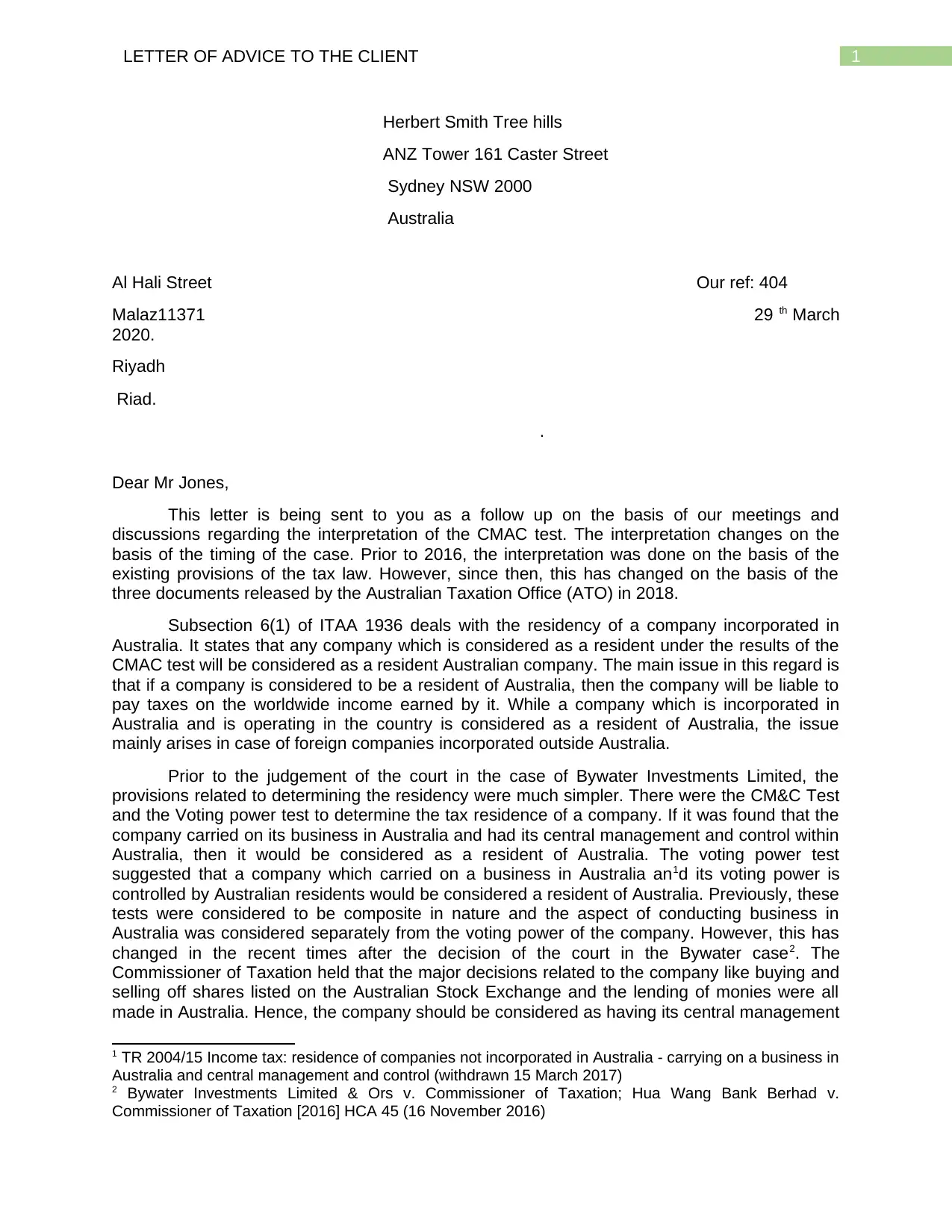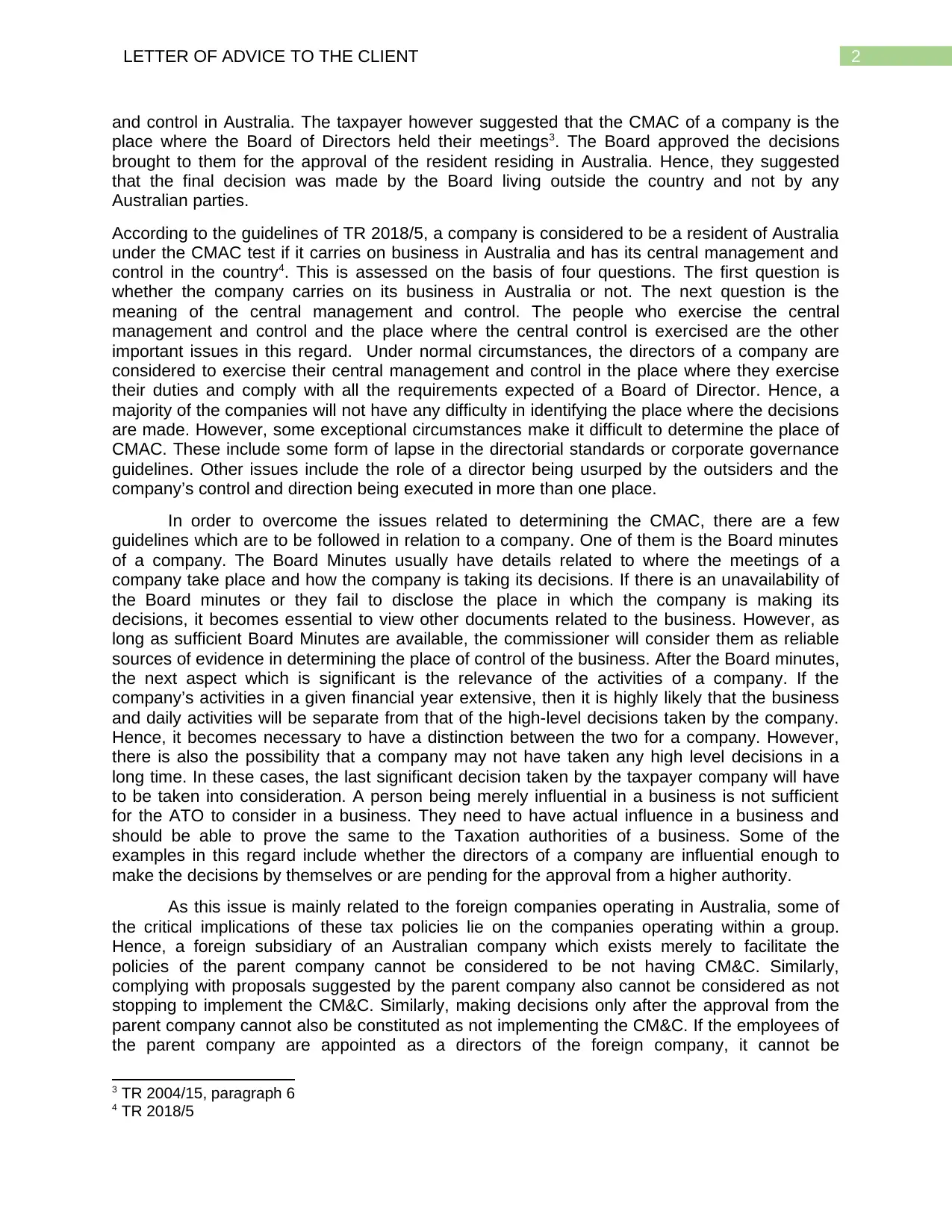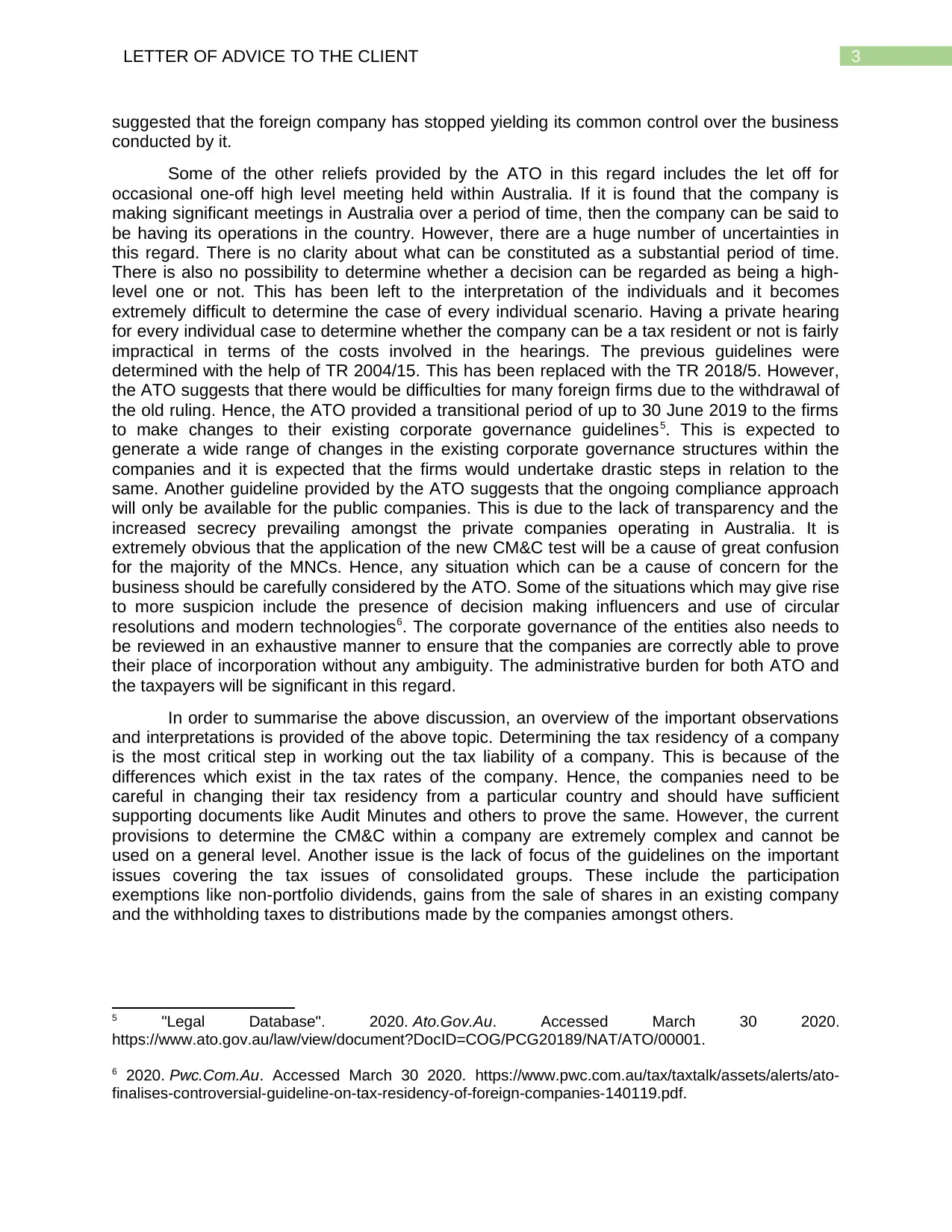Comprehensive Analysis of CMAC Test for Tax Residency
VerifiedAdded on 2022/08/27
|4
|1883
|26
Report
AI Summary
This report provides a letter of advice to a client regarding the interpretation of the Central Management and Control (CMAC) test for corporate residency in Australia. It explains the significant changes introduced by the Australian Taxation Office (ATO) in 2018, particularly with the release of Taxation Ruling TR 2018/5, following the Bywater Investments Limited case. The report details the differences between the pre-2016 interpretation and the current guidelines, focusing on how the CMAC test determines a company's tax residency and its implications on worldwide income taxation. It addresses the application of the CMAC test to various types of foreign companies operating within and outside of Australian groups, including foreign operating companies, foreign intermediate holding companies, and foreign holding companies controlled by Australian groups. The analysis includes the four key questions used to assess CMAC, the importance of board minutes, the relevance of a company's activities, and the influence of key decision-makers. The report also highlights the transitional period provided by the ATO for firms to adjust to the new guidelines, and the ongoing compliance approach for public companies. The report concludes by summarizing the essential observations and interpretations of the CMAC test and its impact on tax liability, emphasizing the need for companies to maintain accurate documentation to prove their tax residency.

Running head: LETTER OF ADVICE TO THE CLIENT
Letter of Advice to the client
Name of the Student
Name of the University
Author Note
Letter of Advice to the client
Name of the Student
Name of the University
Author Note
Paraphrase This Document
Need a fresh take? Get an instant paraphrase of this document with our AI Paraphraser

1LETTER OF ADVICE TO THE CLIENT
Herbert Smith Tree hills
ANZ Tower 161 Caster Street
Sydney NSW 2000
Australia
Al Hali Street Our ref: 404
Malaz11371 29 th March
2020.
Riyadh
Riad.
.
Dear Mr Jones,
This letter is being sent to you as a follow up on the basis of our meetings and
discussions regarding the interpretation of the CMAC test. The interpretation changes on the
basis of the timing of the case. Prior to 2016, the interpretation was done on the basis of the
existing provisions of the tax law. However, since then, this has changed on the basis of the
three documents released by the Australian Taxation Office (ATO) in 2018.
Subsection 6(1) of ITAA 1936 deals with the residency of a company incorporated in
Australia. It states that any company which is considered as a resident under the results of the
CMAC test will be considered as a resident Australian company. The main issue in this regard is
that if a company is considered to be a resident of Australia, then the company will be liable to
pay taxes on the worldwide income earned by it. While a company which is incorporated in
Australia and is operating in the country is considered as a resident of Australia, the issue
mainly arises in case of foreign companies incorporated outside Australia.
Prior to the judgement of the court in the case of Bywater Investments Limited, the
provisions related to determining the residency were much simpler. There were the CM&C Test
and the Voting power test to determine the tax residence of a company. If it was found that the
company carried on its business in Australia and had its central management and control within
Australia, then it would be considered as a resident of Australia. The voting power test
suggested that a company which carried on a business in Australia an1d its voting power is
controlled by Australian residents would be considered a resident of Australia. Previously, these
tests were considered to be composite in nature and the aspect of conducting business in
Australia was considered separately from the voting power of the company. However, this has
changed in the recent times after the decision of the court in the Bywater case2. The
Commissioner of Taxation held that the major decisions related to the company like buying and
selling off shares listed on the Australian Stock Exchange and the lending of monies were all
made in Australia. Hence, the company should be considered as having its central management
1 TR 2004/15 Income tax: residence of companies not incorporated in Australia - carrying on a business in
Australia and central management and control (withdrawn 15 March 2017)
2 Bywater Investments Limited & Ors v. Commissioner of Taxation; Hua Wang Bank Berhad v.
Commissioner of Taxation [2016] HCA 45 (16 November 2016)
Herbert Smith Tree hills
ANZ Tower 161 Caster Street
Sydney NSW 2000
Australia
Al Hali Street Our ref: 404
Malaz11371 29 th March
2020.
Riyadh
Riad.
.
Dear Mr Jones,
This letter is being sent to you as a follow up on the basis of our meetings and
discussions regarding the interpretation of the CMAC test. The interpretation changes on the
basis of the timing of the case. Prior to 2016, the interpretation was done on the basis of the
existing provisions of the tax law. However, since then, this has changed on the basis of the
three documents released by the Australian Taxation Office (ATO) in 2018.
Subsection 6(1) of ITAA 1936 deals with the residency of a company incorporated in
Australia. It states that any company which is considered as a resident under the results of the
CMAC test will be considered as a resident Australian company. The main issue in this regard is
that if a company is considered to be a resident of Australia, then the company will be liable to
pay taxes on the worldwide income earned by it. While a company which is incorporated in
Australia and is operating in the country is considered as a resident of Australia, the issue
mainly arises in case of foreign companies incorporated outside Australia.
Prior to the judgement of the court in the case of Bywater Investments Limited, the
provisions related to determining the residency were much simpler. There were the CM&C Test
and the Voting power test to determine the tax residence of a company. If it was found that the
company carried on its business in Australia and had its central management and control within
Australia, then it would be considered as a resident of Australia. The voting power test
suggested that a company which carried on a business in Australia an1d its voting power is
controlled by Australian residents would be considered a resident of Australia. Previously, these
tests were considered to be composite in nature and the aspect of conducting business in
Australia was considered separately from the voting power of the company. However, this has
changed in the recent times after the decision of the court in the Bywater case2. The
Commissioner of Taxation held that the major decisions related to the company like buying and
selling off shares listed on the Australian Stock Exchange and the lending of monies were all
made in Australia. Hence, the company should be considered as having its central management
1 TR 2004/15 Income tax: residence of companies not incorporated in Australia - carrying on a business in
Australia and central management and control (withdrawn 15 March 2017)
2 Bywater Investments Limited & Ors v. Commissioner of Taxation; Hua Wang Bank Berhad v.
Commissioner of Taxation [2016] HCA 45 (16 November 2016)

2LETTER OF ADVICE TO THE CLIENT
and control in Australia. The taxpayer however suggested that the CMAC of a company is the
place where the Board of Directors held their meetings3. The Board approved the decisions
brought to them for the approval of the resident residing in Australia. Hence, they suggested
that the final decision was made by the Board living outside the country and not by any
Australian parties.
According to the guidelines of TR 2018/5, a company is considered to be a resident of Australia
under the CMAC test if it carries on business in Australia and has its central management and
control in the country4. This is assessed on the basis of four questions. The first question is
whether the company carries on its business in Australia or not. The next question is the
meaning of the central management and control. The people who exercise the central
management and control and the place where the central control is exercised are the other
important issues in this regard. Under normal circumstances, the directors of a company are
considered to exercise their central management and control in the place where they exercise
their duties and comply with all the requirements expected of a Board of Director. Hence, a
majority of the companies will not have any difficulty in identifying the place where the decisions
are made. However, some exceptional circumstances make it difficult to determine the place of
CMAC. These include some form of lapse in the directorial standards or corporate governance
guidelines. Other issues include the role of a director being usurped by the outsiders and the
company’s control and direction being executed in more than one place.
In order to overcome the issues related to determining the CMAC, there are a few
guidelines which are to be followed in relation to a company. One of them is the Board minutes
of a company. The Board Minutes usually have details related to where the meetings of a
company take place and how the company is taking its decisions. If there is an unavailability of
the Board minutes or they fail to disclose the place in which the company is making its
decisions, it becomes essential to view other documents related to the business. However, as
long as sufficient Board Minutes are available, the commissioner will consider them as reliable
sources of evidence in determining the place of control of the business. After the Board minutes,
the next aspect which is significant is the relevance of the activities of a company. If the
company’s activities in a given financial year extensive, then it is highly likely that the business
and daily activities will be separate from that of the high-level decisions taken by the company.
Hence, it becomes necessary to have a distinction between the two for a company. However,
there is also the possibility that a company may not have taken any high level decisions in a
long time. In these cases, the last significant decision taken by the taxpayer company will have
to be taken into consideration. A person being merely influential in a business is not sufficient
for the ATO to consider in a business. They need to have actual influence in a business and
should be able to prove the same to the Taxation authorities of a business. Some of the
examples in this regard include whether the directors of a company are influential enough to
make the decisions by themselves or are pending for the approval from a higher authority.
As this issue is mainly related to the foreign companies operating in Australia, some of
the critical implications of these tax policies lie on the companies operating within a group.
Hence, a foreign subsidiary of an Australian company which exists merely to facilitate the
policies of the parent company cannot be considered to be not having CM&C. Similarly,
complying with proposals suggested by the parent company also cannot be considered as not
stopping to implement the CM&C. Similarly, making decisions only after the approval from the
parent company cannot also be constituted as not implementing the CM&C. If the employees of
the parent company are appointed as a directors of the foreign company, it cannot be
3 TR 2004/15, paragraph 6
4 TR 2018/5
and control in Australia. The taxpayer however suggested that the CMAC of a company is the
place where the Board of Directors held their meetings3. The Board approved the decisions
brought to them for the approval of the resident residing in Australia. Hence, they suggested
that the final decision was made by the Board living outside the country and not by any
Australian parties.
According to the guidelines of TR 2018/5, a company is considered to be a resident of Australia
under the CMAC test if it carries on business in Australia and has its central management and
control in the country4. This is assessed on the basis of four questions. The first question is
whether the company carries on its business in Australia or not. The next question is the
meaning of the central management and control. The people who exercise the central
management and control and the place where the central control is exercised are the other
important issues in this regard. Under normal circumstances, the directors of a company are
considered to exercise their central management and control in the place where they exercise
their duties and comply with all the requirements expected of a Board of Director. Hence, a
majority of the companies will not have any difficulty in identifying the place where the decisions
are made. However, some exceptional circumstances make it difficult to determine the place of
CMAC. These include some form of lapse in the directorial standards or corporate governance
guidelines. Other issues include the role of a director being usurped by the outsiders and the
company’s control and direction being executed in more than one place.
In order to overcome the issues related to determining the CMAC, there are a few
guidelines which are to be followed in relation to a company. One of them is the Board minutes
of a company. The Board Minutes usually have details related to where the meetings of a
company take place and how the company is taking its decisions. If there is an unavailability of
the Board minutes or they fail to disclose the place in which the company is making its
decisions, it becomes essential to view other documents related to the business. However, as
long as sufficient Board Minutes are available, the commissioner will consider them as reliable
sources of evidence in determining the place of control of the business. After the Board minutes,
the next aspect which is significant is the relevance of the activities of a company. If the
company’s activities in a given financial year extensive, then it is highly likely that the business
and daily activities will be separate from that of the high-level decisions taken by the company.
Hence, it becomes necessary to have a distinction between the two for a company. However,
there is also the possibility that a company may not have taken any high level decisions in a
long time. In these cases, the last significant decision taken by the taxpayer company will have
to be taken into consideration. A person being merely influential in a business is not sufficient
for the ATO to consider in a business. They need to have actual influence in a business and
should be able to prove the same to the Taxation authorities of a business. Some of the
examples in this regard include whether the directors of a company are influential enough to
make the decisions by themselves or are pending for the approval from a higher authority.
As this issue is mainly related to the foreign companies operating in Australia, some of
the critical implications of these tax policies lie on the companies operating within a group.
Hence, a foreign subsidiary of an Australian company which exists merely to facilitate the
policies of the parent company cannot be considered to be not having CM&C. Similarly,
complying with proposals suggested by the parent company also cannot be considered as not
stopping to implement the CM&C. Similarly, making decisions only after the approval from the
parent company cannot also be constituted as not implementing the CM&C. If the employees of
the parent company are appointed as a directors of the foreign company, it cannot be
3 TR 2004/15, paragraph 6
4 TR 2018/5
⊘ This is a preview!⊘
Do you want full access?
Subscribe today to unlock all pages.

Trusted by 1+ million students worldwide

3LETTER OF ADVICE TO THE CLIENT
suggested that the foreign company has stopped yielding its common control over the business
conducted by it.
Some of the other reliefs provided by the ATO in this regard includes the let off for
occasional one-off high level meeting held within Australia. If it is found that the company is
making significant meetings in Australia over a period of time, then the company can be said to
be having its operations in the country. However, there are a huge number of uncertainties in
this regard. There is no clarity about what can be constituted as a substantial period of time.
There is also no possibility to determine whether a decision can be regarded as being a high-
level one or not. This has been left to the interpretation of the individuals and it becomes
extremely difficult to determine the case of every individual scenario. Having a private hearing
for every individual case to determine whether the company can be a tax resident or not is fairly
impractical in terms of the costs involved in the hearings. The previous guidelines were
determined with the help of TR 2004/15. This has been replaced with the TR 2018/5. However,
the ATO suggests that there would be difficulties for many foreign firms due to the withdrawal of
the old ruling. Hence, the ATO provided a transitional period of up to 30 June 2019 to the firms
to make changes to their existing corporate governance guidelines5. This is expected to
generate a wide range of changes in the existing corporate governance structures within the
companies and it is expected that the firms would undertake drastic steps in relation to the
same. Another guideline provided by the ATO suggests that the ongoing compliance approach
will only be available for the public companies. This is due to the lack of transparency and the
increased secrecy prevailing amongst the private companies operating in Australia. It is
extremely obvious that the application of the new CM&C test will be a cause of great confusion
for the majority of the MNCs. Hence, any situation which can be a cause of concern for the
business should be carefully considered by the ATO. Some of the situations which may give rise
to more suspicion include the presence of decision making influencers and use of circular
resolutions and modern technologies6. The corporate governance of the entities also needs to
be reviewed in an exhaustive manner to ensure that the companies are correctly able to prove
their place of incorporation without any ambiguity. The administrative burden for both ATO and
the taxpayers will be significant in this regard.
In order to summarise the above discussion, an overview of the important observations
and interpretations is provided of the above topic. Determining the tax residency of a company
is the most critical step in working out the tax liability of a company. This is because of the
differences which exist in the tax rates of the company. Hence, the companies need to be
careful in changing their tax residency from a particular country and should have sufficient
supporting documents like Audit Minutes and others to prove the same. However, the current
provisions to determine the CM&C within a company are extremely complex and cannot be
used on a general level. Another issue is the lack of focus of the guidelines on the important
issues covering the tax issues of consolidated groups. These include the participation
exemptions like non-portfolio dividends, gains from the sale of shares in an existing company
and the withholding taxes to distributions made by the companies amongst others.
5 "Legal Database". 2020. Ato.Gov.Au. Accessed March 30 2020.
https://www.ato.gov.au/law/view/document?DocID=COG/PCG20189/NAT/ATO/00001.
6 2020. Pwc.Com.Au. Accessed March 30 2020. https://www.pwc.com.au/tax/taxtalk/assets/alerts/ato-
finalises-controversial-guideline-on-tax-residency-of-foreign-companies-140119.pdf.
suggested that the foreign company has stopped yielding its common control over the business
conducted by it.
Some of the other reliefs provided by the ATO in this regard includes the let off for
occasional one-off high level meeting held within Australia. If it is found that the company is
making significant meetings in Australia over a period of time, then the company can be said to
be having its operations in the country. However, there are a huge number of uncertainties in
this regard. There is no clarity about what can be constituted as a substantial period of time.
There is also no possibility to determine whether a decision can be regarded as being a high-
level one or not. This has been left to the interpretation of the individuals and it becomes
extremely difficult to determine the case of every individual scenario. Having a private hearing
for every individual case to determine whether the company can be a tax resident or not is fairly
impractical in terms of the costs involved in the hearings. The previous guidelines were
determined with the help of TR 2004/15. This has been replaced with the TR 2018/5. However,
the ATO suggests that there would be difficulties for many foreign firms due to the withdrawal of
the old ruling. Hence, the ATO provided a transitional period of up to 30 June 2019 to the firms
to make changes to their existing corporate governance guidelines5. This is expected to
generate a wide range of changes in the existing corporate governance structures within the
companies and it is expected that the firms would undertake drastic steps in relation to the
same. Another guideline provided by the ATO suggests that the ongoing compliance approach
will only be available for the public companies. This is due to the lack of transparency and the
increased secrecy prevailing amongst the private companies operating in Australia. It is
extremely obvious that the application of the new CM&C test will be a cause of great confusion
for the majority of the MNCs. Hence, any situation which can be a cause of concern for the
business should be carefully considered by the ATO. Some of the situations which may give rise
to more suspicion include the presence of decision making influencers and use of circular
resolutions and modern technologies6. The corporate governance of the entities also needs to
be reviewed in an exhaustive manner to ensure that the companies are correctly able to prove
their place of incorporation without any ambiguity. The administrative burden for both ATO and
the taxpayers will be significant in this regard.
In order to summarise the above discussion, an overview of the important observations
and interpretations is provided of the above topic. Determining the tax residency of a company
is the most critical step in working out the tax liability of a company. This is because of the
differences which exist in the tax rates of the company. Hence, the companies need to be
careful in changing their tax residency from a particular country and should have sufficient
supporting documents like Audit Minutes and others to prove the same. However, the current
provisions to determine the CM&C within a company are extremely complex and cannot be
used on a general level. Another issue is the lack of focus of the guidelines on the important
issues covering the tax issues of consolidated groups. These include the participation
exemptions like non-portfolio dividends, gains from the sale of shares in an existing company
and the withholding taxes to distributions made by the companies amongst others.
5 "Legal Database". 2020. Ato.Gov.Au. Accessed March 30 2020.
https://www.ato.gov.au/law/view/document?DocID=COG/PCG20189/NAT/ATO/00001.
6 2020. Pwc.Com.Au. Accessed March 30 2020. https://www.pwc.com.au/tax/taxtalk/assets/alerts/ato-
finalises-controversial-guideline-on-tax-residency-of-foreign-companies-140119.pdf.
1 out of 4
Related Documents
Your All-in-One AI-Powered Toolkit for Academic Success.
+13062052269
info@desklib.com
Available 24*7 on WhatsApp / Email
![[object Object]](/_next/static/media/star-bottom.7253800d.svg)
Unlock your academic potential
Copyright © 2020–2025 A2Z Services. All Rights Reserved. Developed and managed by ZUCOL.





